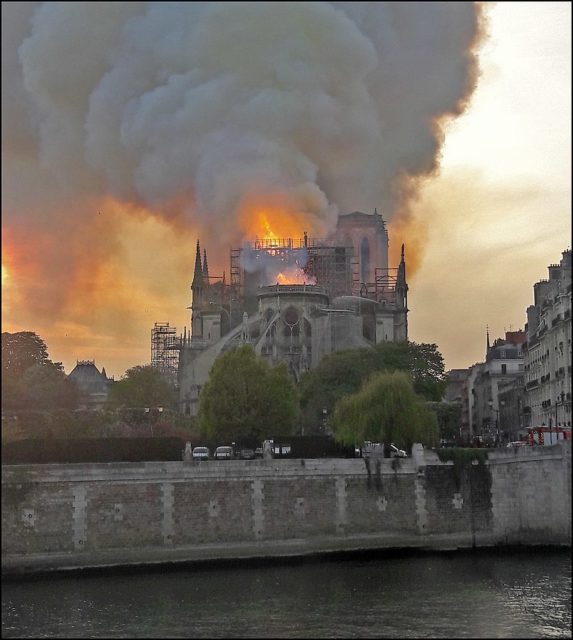There have been other incidents since the fire, most pressingly the horrific bombing attacks on Easter Sunday in Sri Lanka, but David Warren would still like us to remember what happened a week ago in Paris:
A week has passed since the fire in, or on, Notre Dame de Paris; let me be the last to comment on a story that is stale-dated by any meejah standard. It dominated international mindwaves for only two days, but left images that viewers may be able to recall many decades from now.
“The church is on fire,” is a commonplace thought, when a church is visibly on fire, and I who am commonplace was thinking that while turning to the news. As an old meejah hack, who happens to know a little about Gothic architecture, I was prepared to discount the “fake news” that would be disseminated in “live time.” For instance, when told that the roof had collapsed, with strong hints that the building was now a write-off, I reflected that the roof is a hat, only. Stone vaulting lies underneath it, except the circle much of the spire fell through (as burnt offering onto the altar). Stone doesn’t burn easily; and even fallen vaulting can be repaired, having been erected with technology we would consider primitive today.
A spectacle: to see the ancient oak timbers, of great girth, burning up like matchsticks. But the craft masons of Notre Dame — far, far in advance of our modern Lego builders — expected fire and lived in a time so simple that they knew oak doesn’t burn without help. It isn’t big matchsticks. The idea that you need some serious accelerants to make it burn, and that only the accelerants would flame like that, was among my initial thoughts. We’ll see what comes of investigations. I also recalled two recent attempts to torch the cathedral, associated with terrorism.
Instead, the explanation of a clumsy accident by restoration workers was immediately accepted by the talking heads, and even Fox News hung up on a guest who had another theory. In favour of the politically correct, plausible account, I learnt that a fire alarm had sounded 23 minutes before the blaze itself was spotted. Paradoxically, this showed the ruinous consequences of depending exclusively on modern technology: the computers directed the first responders to the wrong place, away from the actual heat source.
I can easily believe in electrical short circuits as a fire hazard, especially since having had myself to flee a building where a cost-cutting landlord was having an elevator repaired by what I characterized as “a Romanian comedy team.” (They buzz-sawed through a live electrical cable, then themselves fled the scene of their handiwork as smoke shot up the shaft through the building. Luckily this smoke warned all tenants to evacuate; the building’s siren alone would have been taken by everyone as yet another false alarm.)




